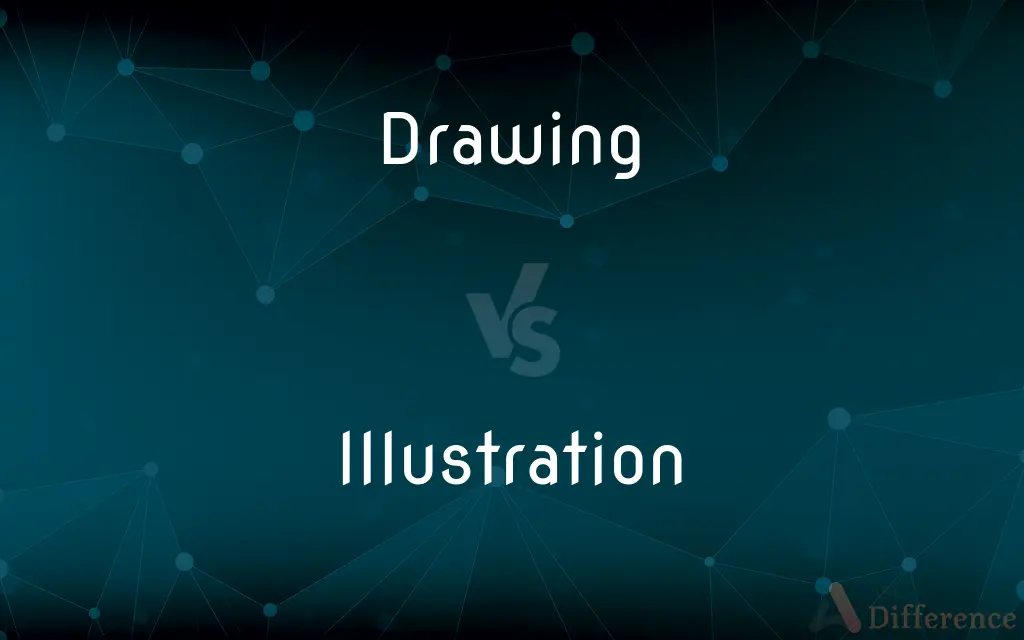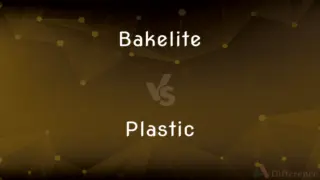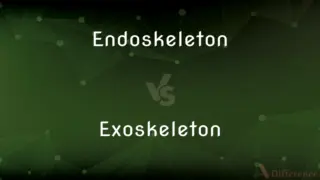Drawing vs. Illustration — What's the Difference?
By Tayyaba Rehman & Maham Liaqat — Updated on March 14, 2024
Drawing emphasizes the act or skill of creating a picture with pens, pencils, or similar tools, while illustration specifically refers to a visual explanation or decoration of text, concepts, or processes.

Difference Between Drawing and Illustration
Table of Contents
ADVERTISEMENT
Key Differences
Drawing is a fundamental artistic technique involving the use of various tools like pencils, pens, or charcoal to create images on a surface, primarily focusing on the physical act of marking. Illustration, on the other hand, serves a more defined purpose, often used to visually explain, clarify, or decorate written text, concepts, or ideas, thus bridging the gap between art and communication.
While drawing can stand alone as an independent art form, expressing personal artistic vision or practice, illustration is typically tied to accompanying text or concepts, aiming to enhance or elucidate them. For example, drawings may be appreciated for their aesthetic or technical merits, whereas illustrations are often evaluated based on how effectively they communicate or complement a narrative or idea.
In terms of application, drawing can range from quick sketches to detailed artworks, with artists exploring various themes, emotions, and subjects without the necessity of an accompanying narrative. Illustration, however, is often found in books, magazines, advertisements, and digital media, with a clear intent to convey specific messages or support textual content.
The skill sets for drawing and illustration overlap, with both requiring a mastery of artistic techniques. However, illustration also demands a strong understanding of storytelling, communication, and sometimes graphic design principles, to effectively marry visual art with its intended context or message.
Comparison Chart
Definition
The act or skill of producing images on a surface using pens, pencils, or other tools.
A visual explanation, interpretation or decoration of text, concepts, or processes.
ADVERTISEMENT
Purpose
Artistic expression, exploration of visual ideas.
To elucidate, decorate, or visually communicate specific ideas, often in conjunction with text.
Context
Can be independent or part of broader artistic works.
Usually accompanies text, concepts, or narratives in various media.
Focus
Technique, expression, individual vision.
Communication, narrative support, clarification.
Skills Required
Artistic technique, creativity.
Artistic technique, communication, storytelling, sometimes graphic design.
Compare with Definitions
Drawing
The creation of a picture or diagram made with a pencil, pen, or crayon rather than paint.
The artist spent hours perfecting his drawing.
Illustration
A picture or diagram that helps make something clear or attractive.
The book had beautiful illustrations on every page.
Drawing
A technique involving lines and shades to create forms on a surface.
She is taking a course to improve her drawing skills.
Illustration
The act of clarifying or explaining through visual representation.
Her presentation included detailed illustrations of the process.
Drawing
The selection or making of a winner in a contest by random drawing.
They announced the drawing for the raffle tickets.
Illustration
The profession or art of creating images to accompany text.
He pursued a career in illustration after studying fine arts.
Drawing
The act of pulling or dragging, as in "drawing water from a well."
Drawing water from the river was their daily chore.
Illustration
An example that serves to clarify or prove something.
This case is a perfect illustration of the principle in action.
Drawing
The process of extracting or pulling out, as in "drawing conclusions."
After analyzing the data, they began drawing conclusions.
Illustration
The use of examples to make something easier to understand.
The teacher used illustrations from everyday life to explain the concept.
Drawing
Drawing is a form of visual art in which an artist uses instruments to mark paper or other two-dimensional surface. Drawing instruments include graphite pencils, pen and ink, various kinds of paints, inked brushes, colored pencils, crayons, charcoal, chalk, pastels, erasers, markers, styluses, and metals (such as silverpoint).
Illustration
An illustration is a decoration, interpretation or visual explanation of a text, concept or process, designed for integration in print and digital published media, such as posters, flyers, magazines, books, teaching materials, animations, video games and films. An illustration is typically created by an illustrator.
Drawing
The act or an instance of drawing.
Illustration
A picture illustrating a book, newspaper, etc.
An illustration of a yacht
Drawing
The art of representing objects or forms on a surface chiefly by means of lines.
Illustration
The action or fact of illustrating something
By way of illustration, I refer to the following case
Drawing
A work produced by this art.
Illustration
The act of illustrating or the state of being illustrated
Concepts that would benefit from illustration.
An idea that lends itself to illustration.
Drawing
Present participle of draw
Illustration
A picture or image that is used to decorate or clarify a text.
Drawing
A picture, likeness, diagram or representation, usually drawn on paper.
Illustration
An example that is used to clarify or explain something.
Drawing
The act of producing such a picture.
Illustration
(Obsolete) Illumination.
Drawing
Such acts practiced as a graphic art form.
Illustration
The act of illustrating; the act of making clear and distinct;
Drawing
The process of drawing or pulling something.
Proverb: An official is great in his office as a well is rich in drawings of water.
Illustration
The state of being illustrated, or of being made clear and distinct.
Drawing
An act or event in which the outcome (e.g., designating a winner) is selected by chance in the form of a blind draw, notably of lots; especially such a contest in which a winning name or number is selected randomly by removing (or drawing) it from a container, popularly a hat.
Illustration
Something which illustrates; a comparison or example intended to make clear or apprehensible, or to remove obscurity.
Drawing
A small portion of tea for steeping.
Illustration
A picture designed to decorate a publication, or elucidate a literary work.
The illustration showing the water cycle made it much easier to understand for the children.
The sleeve of the band's new CD includes illustrations from deceased former members.
Drawing
The act of pulling, or attracting.
Illustration
A calculated prevision of insurance premiums and returns (life insurance)
Drawing
The act or the art of representing any object by means of lines and shades; especially, such a representation when in one color, or in tints used not to represent the colors of natural objects, but for effect only, and produced with hard material such as pencil, chalk, etc.; delineation; also, the figure or representation drawn.
Illustration
The act of illustrating; the act of making clear and distinct; education; also, the state of being illustrated, or of being made clear and distinct.
Drawing
The process of stretching or spreading metals as by hammering, or, as in forming wire from rods or tubes and cups from sheet metal, by pulling them through dies.
Illustration
That which illustrates; a comparison or example intended to make clear or apprehensible, or to remove obscurity.
Drawing
The process of pulling out and elongating the sliver from the carding machine, by revolving rollers, to prepare it for spinning.
Illustration
A picture designed to decorate a volume or elucidate a literary work.
Drawing
The distribution of prizes and blanks in a lottery.
Illustration
Artwork that helps make something clear or attractive
Drawing
An illustration that is drawn by hand and published in a book or magazine;
It is shown by the drawing in Fig. 7
Illustration
Showing by example
Drawing
A representation of forms or objects on a surface by means of lines;
Drawings of abstract forms
He did complicated pen-and-ink drawings like medieval miniatures
Illustration
An item of information that is representative of a type;
This patient provides a typical example of the syndrome
There is an example on page 10
Drawing
The creation of artistic drawings;
He learned drawing from his father
Illustration
A visual representation (a picture or diagram) that is used make some subject more pleasing or easier to understand
Drawing
Players buy (or are given) chances and prizes are distributed according to the drawing of lots
Drawing
Act of getting or draining something such as electricity or a liquid from a source;
The drawing of water from the well
Drawing
The act of moving a load by drawing or pulling
Common Curiosities
How is the context of use different between drawing and illustration?
Drawings can be independent artworks or part of larger pieces, whereas illustrations are typically found alongside text or narratives in books, media, and advertisements.
What is the primary purpose of drawing?
The primary purpose of drawing is artistic expression and exploration of visual ideas through lines and shades.
How does illustration differ from drawing in its intent?
Illustration specifically aims to elucidate, decorate, or visually communicate ideas, often accompanying text or concepts.
Can a drawing serve as an illustration?
Yes, a drawing can serve as an illustration if it is used to visually explain or complement text, concepts, or narratives.
Can illustrations be purely decorative?
Yes, illustrations can be purely decorative, aiming to embellish a page or text without necessarily conveying additional information.
How do illustrations enhance reading experiences in books or articles?
Illustrations enhance reading experiences by providing visual explanations or decorations that complement and clarify the text, making it more engaging and understandable.
What skills are essential for illustration beyond those required for drawing?
Beyond artistic techniques, illustration requires skills in communication, storytelling, and sometimes graphic design to effectively convey messages.
How do illustrators choose the style of their illustrations?
Illustrators choose their style based on the content, audience, and medium of the text or concept they are complementing, aiming for coherence and impact.
How do cultural influences impact illustration styles?
Cultural influences significantly impact illustration styles, with illustrators incorporating elements from their cultural background or the cultural context of the text they are illustrating.
Is the term "drawing" applicable to digital art?
Yes, the term "drawing" can apply to digital art, where artists use digital tools to create images that resemble traditional drawing techniques.
How has digital technology influenced the fields of drawing and illustration?
Digital technology has expanded the possibilities in both drawing and illustration, introducing new tools, techniques, and platforms for creation and distribution.
Are all drawings considered art?
While all drawings involve an artistic process, not all are considered "art" in the traditional sense; some may be more functional or practice-oriented.
What role does creativity play in both drawing and illustration?
Creativity is fundamental in both drawing and illustration, driving the creation of unique, expressive, and effective visual representations.
Can the same image be considered both a drawing and an illustration?
Yes, the same image can be considered both a drawing and an illustration, depending on its context and purpose.
How do personal style and technique influence a drawing or illustration?
Personal style and technique greatly influence the uniqueness, expressiveness, and effectiveness of a drawing or illustration, reflecting the artist's or illustrator's individual vision and approach.
Share Your Discovery

Previous Comparison
Bakelite vs. Plastic
Next Comparison
Endoskeleton vs. ExoskeletonAuthor Spotlight
Written by
Tayyaba RehmanTayyaba Rehman is a distinguished writer, currently serving as a primary contributor to askdifference.com. As a researcher in semantics and etymology, Tayyaba's passion for the complexity of languages and their distinctions has found a perfect home on the platform. Tayyaba delves into the intricacies of language, distinguishing between commonly confused words and phrases, thereby providing clarity for readers worldwide.
Co-written by
Maham Liaqat














































